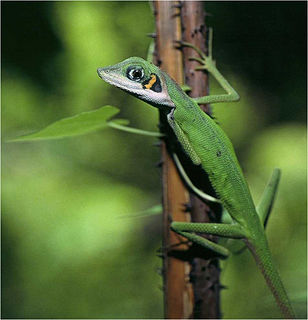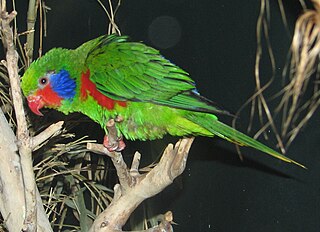
Hoplocercidae are a family of lizards native to the tropical forests, woodlands and savanna-like habitats of Central and South America. Alternatively they are recognized as a subfamily, Hoplocercinae. Sixteen species in three genera are described.

Bronchocela is a genus of Asian lizards in the family Agamidae.

Calotes is a genus of lizards in the draconine clade of the family Agamidae. The genus contains 25 species. Some species are known as forest lizards, others as "bloodsuckers" due to their red heads, and yet others as garden lizards.

Trapelus is a genus of Middle Eastern agamid lizards, which contains 13 species.

Bronchocela cristatella, also known as the green crested lizard, is a species of agamid lizard endemic to Southeast Asia.

Bronchocela danieli is a species of agamid lizard found in Campbell Bay, Great Nicobar Island, India.

Bronchocela jubata, commonly known as the maned forest lizard, is a species of agamid lizard found mainly in Indonesia on the islands of Singkep, Java, Bali, Sulawesi, Karakelang, Salibabu; Nias Island, Singkap Island, Borneo (Kalimantan) also in Thailand, Cambodia and Philippines. Although in the past it was thought the species may be found in India, either on the mainland or in the Nicobars, this is not the case according to herpetologist Das. It is also known by the common name of "bloodsucker", although this is a misnomer.

Mount Salak is an eroded volcano in West Java, Indonesia. It has several satellite cones on its southeast flank and the northern foot, along with two additional craters at the summit. Mount Salak has been evaluated for geothermal power development. According to a popular belief, the name "Salak" derived from salak, a tropical fruit with scaly skin; however, according to Sundanese tradition, the name was derived from the Sanskrit word Salaka which means "silver". Mount Salak can be translated to "Silver Mountain" or "Mount Silver".
Jivanayakam Cyril Daniel, or J.C., as he was known, was an Indian naturalist, and the author of several acclaimed books on birds, mammals, and reptiles.

Charmosyna is a genus of parrot in the family Psittaculidae. It contains the following species:

The Draconinae are a subfamily of reptiles in the family Agamidae found in southern Asia and Oceania. Some taxonomists believe these genera belong to the subfamily Agaminae.

Bronchocela marmorata, marbled crested lizard, marbled bloodsucker or marbled agamid lizard is a species of lizard. It is endemic to the Philippines, where it inhabits lowland dipterocarp and montane forests at elevations 400 to 800 m above mean sea level. It is typically found on branches and leaves of trees. It feeds on insects and is oviparous, digging the soil to lay its eggs at the base of trees.
Trapelus rubrigularis, the red-throated agama, is a species of agama found in Pakistan.
Bronchocela burmana, the Burmese green crested lizard, is a species of agamid lizard. It is endemic to Malay Peninsula and is known from southern Myanmar and Thailand.
Bronchocela celebensis, the Sulawesi bloodsucker, is a species of lizard. It is endemic to Indonesia.
Bronchocela hayeki, the Sumatra bloodsucker, is a species of lizard. It is endemic to Indonesia.
Bronchocela orlovi, Orlov’s forest lizard, is a species of lizard. It is endemic to Vietnam
Bronchocela rayaensis, the Gunung Raya green-crested lizard, is a species of agamid lizard. It is endemic to Malay Peninsula and is known from Langkawi in Kedah, northwestern part of Peninsular Malaysia, as well as from Phuket and Phang Nga Provinces in southern Thailand.
Bronchocela shenlong is a species of lizard. It is endemic to Malaysia
Bronchocela vietnamensis is a species of lizard. It is endemic to Vietnam









